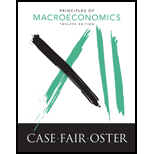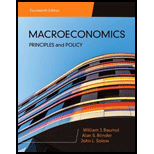
The relationship between MPC and MPS and
Explanation of Solution
Option (a):
MPC is the marginal propensity to consume which represents that portion of change in income that is consumed or spent.
Option (b):
MPS is the marginal propensity to save which represents that portion of change in income that is saved.
Option (c):
Aggregate output refers to the total quantity of goods and services produced over a given period of time in an economy.
Option (d):
Aggregate income refers to the total amount received by all factors of production in a given time period.
The relationship between MPC and MPS can be established as follows:
Since all the income is either consumed (spent) or saved;
The relationship between aggregate output and aggregate income is that both are actually the same thing viewed from different points.
Concept introduction:
Marginal propensity to consume (MPC): Marginal propensity to consume refers to the sensitivity of change in the consumption level due to the changes occurred in the income level.
Marginal propensity to save (MPS): The ratio of change in saving when there is a change in disposable income.
Want to see more full solutions like this?
Chapter 8 Solutions
Principles of Macroeconomics (12th Edition)
- (c) Assume an infinite horizon, continuous time and certainty. Furthermore, assume an additively separable utility function in consumption C and pollution stock S so that, U(C,S) = u(C) + v(S), where uc > 0; Ucc 0. Note that the first derivative, and the second subscript denotes the second derivative. The evolution of the pollution stock S over time is a function of consumption, decay rate of the stock of pollution & and abatement through the function, g(S) with gs > 0 and 9ss < 0. Time subscripts are ignored for ease of notation. Show that in the case of a stock pollutant, the marginal utility of consumption should equal the present value of disutility associated with the pollution stock. Interpret the condition.arrow_forwardQ3/for a closed loop system whose block diagram is shown in the figure determine the values of K and t such that the maximum overshoot to the unit step input is 25% and time to peak is 2 sec K 1+TS $2arrow_forward2. Question The 'Democratic Family' consists of three members {mother m, father f, daughter d}, that have different preferences with respect to how much money X € [0,8] they think should be invested in the new family car. These preferences can be represented by the following utility functions: - Mother m: um(X) = 2X - X² Father f: uf(X) = 10X - X² - Daughter d: ud(X) = 4X - X² Calculate for each family member (f, m, d) the preferred amount of money to invest in the new car denoted by X; for i = {m, f,d}. Assume that (Xf, Xm, Xd) are the three alternatives on which the family must decide. Show that each family member has rational preferences over this domain. Preferences on the family level are determined by pairwise majority voting (all family members vote on two alternatives). Derive the family preference and check whether it is rational. Assume that the final family decision is made by conducting sequential pair- wise majority voting, where the loosing alternative is eliminated. Does…arrow_forward
- 3. Question You invented a new lateral-flow test for asymptomatic Covid-19 detection, where saliva is entered into a test-tube and then the result is shown directly on the device. However, to save on costly chemicals you designed the tests such that it always reports a negative test result. Assume that the incidence rate is 5 per 1000 and that your test is used for detection of asymptomatic cases (without symptoms). (a) Calculate the probability that 100 randomly determined volunteers receive a correct test result by using the AND-rule and the OR-rule. Can your test be qualified as a diagnostic test? (b) The health authorities are investigating the performance of your test. Government guidelines require a specificity (conditional probability to re- ceive a negative test result given that the test-taker is not infected with COVID19) of at least 97% and a sensitivity (conditional probability to receive a positive test result given that the test-taker is infected with COVID-19) of at…arrow_forward3. Question You invented a new lateral-flow test for asymptomatic Covid-19 detection, where saliva is entered into a test-tube and then the result is shown directly on the device. However, to save on costly chemicals you designed the tests such that it always reports a negative test result. Assume that the incidence rate is 5 per 1000 and that your test is used for detection of asymptomatic cases (without symptoms). (a) Calculate the probability that 100 randomly determined volunteers receive a correct test result by using the AND-rule and the OR-rule. Can your test be qualified as a diagnostic test? (b) The health authorities are investigating the performance of your test. Government guidelines require a specificity (conditional probability to re- ceive a negative test result given that the test-taker is not infected with COVID19) of at least 97% and a sensitivity (conditional probability to receive a positive test result given that the test-taker is infected with COVID-19) of at…arrow_forwardI need expert handwritten solutionsarrow_forward
- machine A operated manually cost 2000naira has a life of 2 years, while an automatic machine B cost 5000naira but has a life of 4 years,operating cost for machine A is 4000naira per year while of machine B is 3000naira only, which should be purchased?consider 10% interest I need expert handwritten solutionsarrow_forwardDon't used Ai solutionarrow_forwardNot use ai pleasearrow_forward





 Economics (MindTap Course List)EconomicsISBN:9781337617383Author:Roger A. ArnoldPublisher:Cengage Learning
Economics (MindTap Course List)EconomicsISBN:9781337617383Author:Roger A. ArnoldPublisher:Cengage Learning





